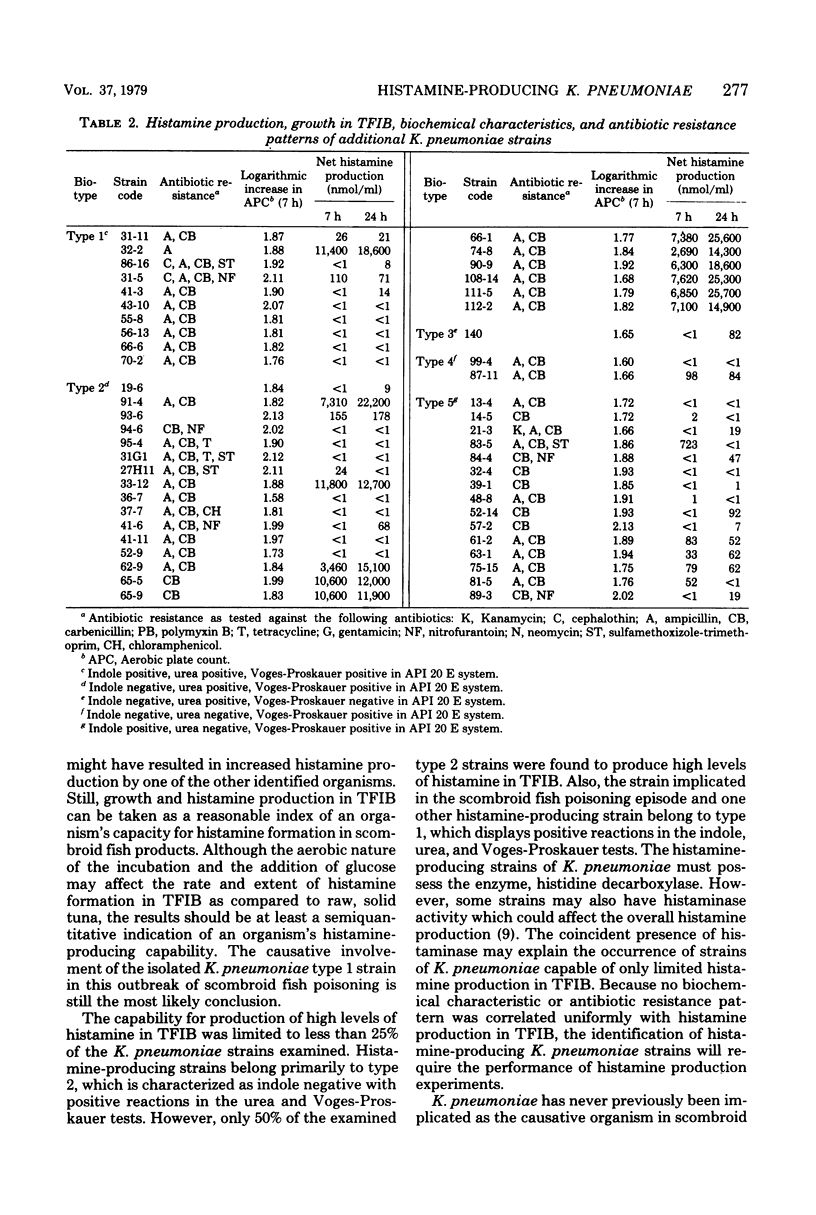Abstract
A histamine-producing strain of Klebsiella pneumoniae was isolated from a sample of tuna sashimi implicated in an outbreak of scombroid fish poisoning. None of the other nine gram-negative bacterial strains isolated from the tuna sashimi was capable of equivalent histamine production. Bacterial histamine production was monitored in a tuna fish infusion broth (TFIB), and the implicated K. pneumoniae was capable of producing 442 mg of histamine per 100 g of tuna in TFIB in 7 h under controlled incubation conditions. Only 12 of 50 other K. pneumoniae strains, representing 5 distinct biochemical types, which had been originally isolated from foods, were able to produce such levels of histamine in TFIB. No correlation was found between histamine production and other biochemical characteristics or antibiotic resistance. Of the 12 histamine-producing strains, 11 belonged to type 2, which is characterized as indole negative with positive reactions in the urea and Voges-Proskauer tests. However, only 50% of the type 2 strains examined produced high levels of histamine in TFIB. Additionally, the implicated K. pneumoniae strain and one other strain belonged to type 1, which is characterized by positive reactions in the indole, urea, and Voges-Proskauer tests.
Full text
PDF




Selected References
These references are in PubMed. This may not be the complete list of references from this article.
- Bauer A. W., Kirby W. M., Sherris J. C., Turck M. Antibiotic susceptibility testing by a standardized single disk method. Am J Clin Pathol. 1966 Apr;45(4):493–496. [PubMed] [Google Scholar]
- Cheeseman G. C., Fuller R. A study by high voltage electrophoresis of the amino acid decarboxylases and arginine dihydrolase of bacteria isolated from the alimentary tract of pigs. J Appl Bacteriol. 1966 Dec;29(3):596–606. doi: 10.1111/j.1365-2672.1966.tb03513.x. [DOI] [PubMed] [Google Scholar]
- Ferencík M. Formation of histamine during bacterial decarboxylation of histidine in the flesh of some marine fishes. J Hyg Epidemiol Microbiol Immunol. 1970;14(1):52–60. [PubMed] [Google Scholar]
- Hughes J. M., Horwitz M. A., Merson M. H., Barker W. H., Jr, Gangarosa E. J. Foodborne disease outbreaks of chemical etiology in the United States, 1970-1974. Am J Epidemiol. 1977 Mar;105(3):233–244. doi: 10.1093/oxfordjournals.aje.a112379. [DOI] [PubMed] [Google Scholar]
- Ieniştea C. Bacterial production and destruction of histamine in foods, and food poisoning caused by histamine. Nahrung. 1971;15(1):109–113. doi: 10.1002/food.19710150115. [DOI] [PubMed] [Google Scholar]
- Merson M. H., Baine W. B., Gangarosa E. J., Swanson R. C. Scombroid fish poisoning. Outbreak traced to commercially canned tuna fish. JAMA. 1974 Jun 3;228(10):1268–1269. doi: 10.1001/jama.228.10.1268. [DOI] [PubMed] [Google Scholar]
- RODWELL A. W. The occurrence and distribution of amino-acid decarboxylases within the genus Lactobacillus. J Gen Microbiol. 1953 Apr;8(2):224–232. doi: 10.1099/00221287-8-2-224. [DOI] [PubMed] [Google Scholar]
- Seidler R. J., Knittel M. D., Brown C. Potential pathogens in the environment: cultural reactions and nucleic acid studies on Klebsiella pneumoniae from clinical and environmental sources. Appl Microbiol. 1975 Jun;29(6):819–825. doi: 10.1128/am.29.6.819-825.1975. [DOI] [PMC free article] [PubMed] [Google Scholar]


